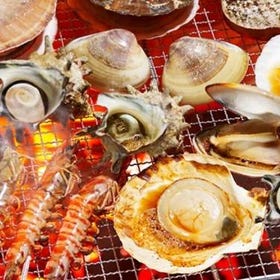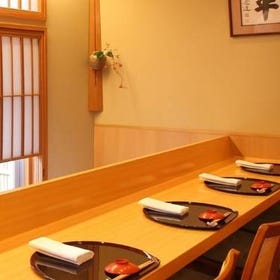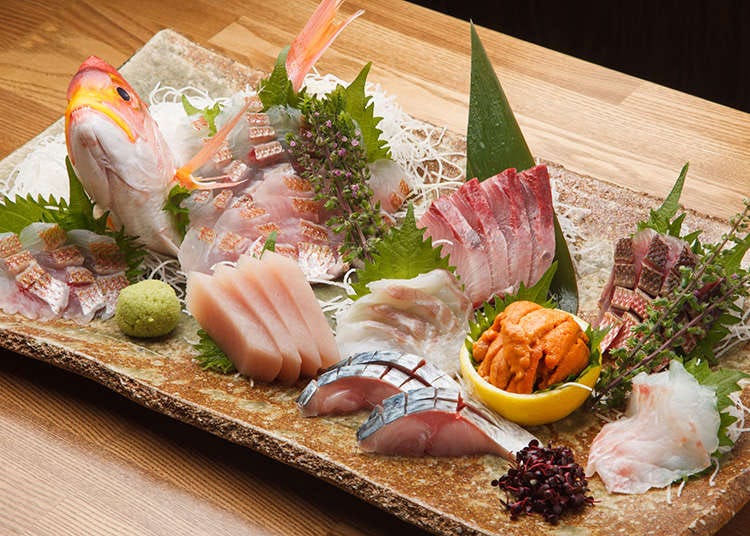
What is Sashimi? Essential Dining Guide to Japan's Famous 'Raw Seafood'
- Written by: Dave Conklin
Sashimi is one of the most common things served in Japanese restaurants—especially sushi restaurants and izakaya. Also known as otsumami (in sushi shops), sashimi usually consists of slices of raw fish, often garnished with a pile of finely cut daikon radish “needles” and a shiso leaf or two.
Other vegetables—often from the sea—as well as intricately cut pieces of radish or carrot and even small flowers can be included to add a bit of color to the presentation.
But what types of sashimi are there, does “sashimi” only involve raw fish, and how does one eat sashimi? This complete guide will share the intriguing answers to these and many more questions!
What is sashimi?

Sashimi generally comes with a bit of wasabi and a small dish for shōyu (Japanese soy sauce) to dip into. In the past, karashi (spicy mustard) was more commonly served rather than wasabi.
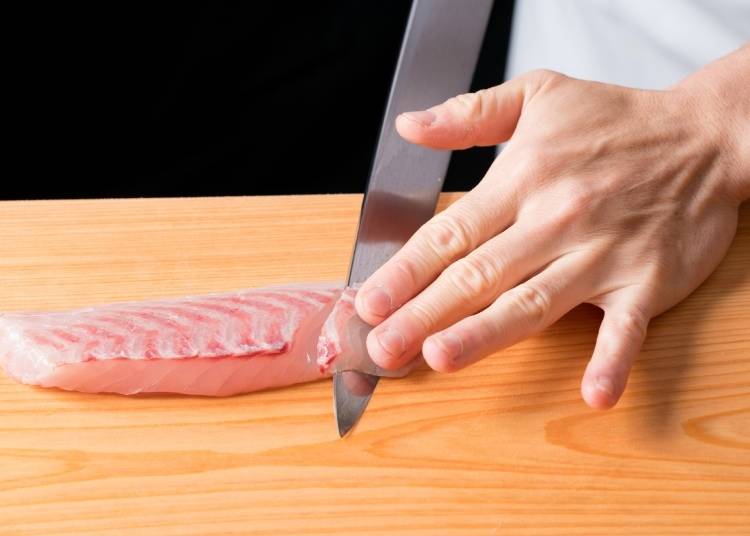
Not all fish can be served raw as sashimi; the fish requires special handling, starting with being caught on hooks and line and then quickly killed using a technique known as ikejimi, where a sharp spike is inserted into the brain of a live fish, the fish then quickly placed in a tub of ice and water. This greatly minimizes the formation of lactic acid and keeps the meat firm and fresh.
A brief history of sashimi
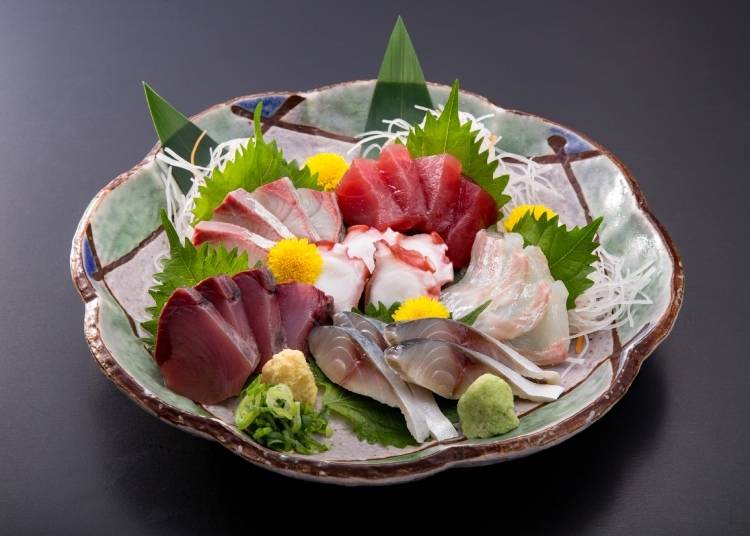
Today we can only guess who the first person to eat raw fish or what kind of fish it was, although it was most likely an oyster thousands of years ago in multiple places around the world. The earliest concrete evidence of something like sashimi being in Japan comes from a record from 1440, the sashimi being raw tai (snapper) marinated in shōyu and called namasu.
Seafood used for sashimi
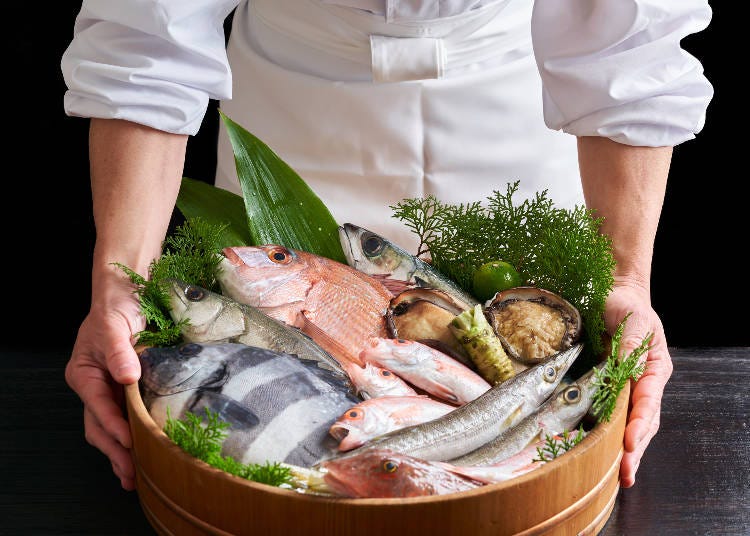
Any and all saltwater fish and shellfish can be served as sashimi, as long as it is properly handled and prepared. Shrimp and other crustaceans are usually boiled or grilled before being served as sashimi. Due to the potential for containing harmful parasites, freshwater fish should not be eaten raw, the exception being koi (carp). In most cases, salmon should be flash-frozen when eaten raw.
Not only seafood is eaten as sashimi in Japan. Other common meats include horse (basashi), and chicken (usually tori-sashimi). Even pork is eaten raw, as is beef.
Preparation
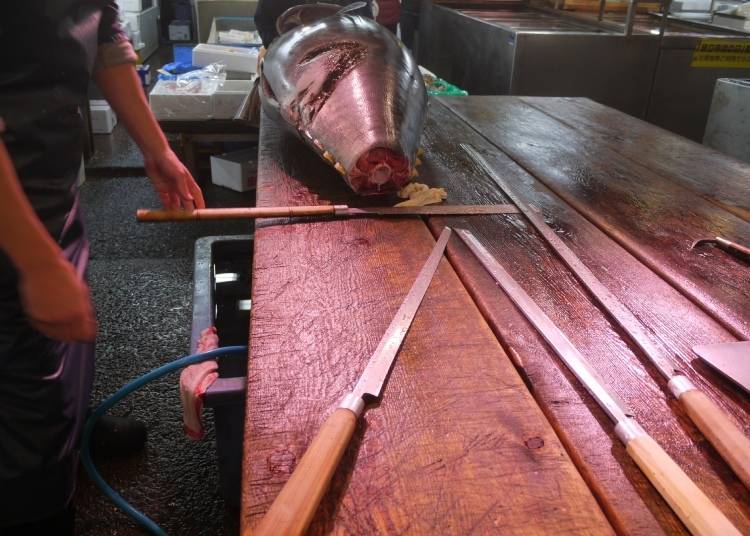
The most popular style is thinly sliced sashimi, called tsukuri. Special sashimi knives are being sold by specialty stores to make these thin, beautiful fresh fish cuts. Usuzukuri is another method of sashimi preparation, cutting the seafood in even thinner cuts and making it appear transparent – ordering usuzukuri sashimi is sure to grant a feast for the eyes.
When the seafood is lightly roasted with green onions and ginger, the sashimi is called tataki. One of the most prominent fish to use for tataki sashimi is bonito. When a fish or seafood is put in an ice and water bath to tighten its muscles, the sashimi is called “arai.” Sometimes, a fish might be still alive while being served, in which case it is referred to as “ikizukuri,” while eating shrimp alive is called “odorigui,” literally translating to “dancing meal.”
Preparing sashimi begins with filleting a whole fish either daimyo oroshi style for small fish such as iwashi (sardine) or aji (horse mackerel) or sanmai oroshi style for larger fish using a heavy deba. From there, the fillets are cut into smaller pieces, often using a long yanagiba knife.
For giant maguro tuna, special long, flexible knives are used to cut the fish into two giant fillets before it is cut into pieces of specific quality and fattiness with smaller knives. Special, extra thin knives are used to slice fugu (pufferfish) into pieces so thin the sashimi is translucent, which is why it is usually served on a colorful platter of the customer’s choosing.
One popular way to prepare katsuo (skipjack tuna) is tataki style, where a loin (quarter) of the fish is either singed with a blowtorch or over burning straw, then sliced and served most often with ponzu, finely chopped negi onions, and perhaps grated ginger or garlic.
Octopus is usually boiled first, often in a semi-sweet mix of shōyu and sake. Some restaurants even serve sashimi freshly sliced off the body of the still-living fish in a style known as ikedsukuri!
How to eat sashimi
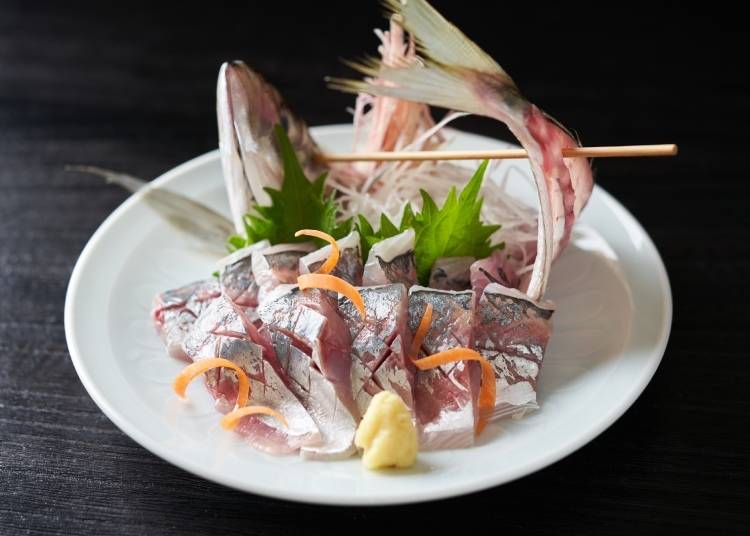
While putting a small dab of wasabi on a piece of sashimi and then dipping it into a small dish of shōyu is the standard way of eating sashimi for many types of fish, it is not the only way.
“Blue” fish—small fish with a bluish skin color—such as iwashi (sardines) and aji (horse mackerel) are often served with grated ginger instead of wasabi, while katsuo (skipjack tuna) and fugu (puffer fish) are commonly served with ponzu, a mix of shōyu and citrus juice.
Also, not all types of shōyu are the same; as a general rule, the farther west you go in Japan, the sweeter the shōyu will be. Some restaurants recommend white fish such as hirame or karei (types of flounder) be eaten with a bit of salt.
Where to eat sashimi
Besides being the starting course at most sushi restaurants, sashimi is almost always available at izakayas as well as at many higher-end soba restaurants. It is also an important part of traditional kaiseki meals. Small trays of sashimi can also be purchased at supermarkets and most “konbini” (convenience stores) for eating at home or on picnics.
How and what to order

Ordering sashimi should not be too difficult, even if you can’t speak or read much, if any, Japanese. If you want to eat some sashimi at a sushi restaurant, it is usually the first thing ordered. Unless you know something specific you want to eat, just ask for “sashimi mori-awase” meaning an assortment of sashimi. Hold up one finger for a serving for one person, two fingers for two people, etc. It is common to share. The chef will do the rest.
- Japanese
- English
- Katsuo
- Bonito/Skipjack tuna
- Sake
- Salmon
- Maguro
- Bluefin tuna
- Ahi
- Yellowfin & bigeye tuna
- Engawa
- Halibut
- Hotate
- Scallops
- Ebi
- Shrimp/prawns
- Ika
- Squid
- Tako
- Octopus
- Saba
- Japanese mackerel
- Aji
- Horse mackerel
- Hamachi/Kanpachi
- Yellowtail
- Tai
- Red snapper
- Sanma
- Pacific saury/Mackerel
Most izakaya have a selection of sashimi. As with dining at sushi shops, sashimi is usually the first food ordered, and again, shared between the members of your party. If you can’t read the menu, just take a look around the restaurant to see if others are eating sashimi. If so, again order “sashimi mori-awase.” Many soba restaurants as well as some tenpura places will have a limited selection of sashimi on the menu, usually including maguro tuna and perhaps some shime saba (lightly pickled mackerel).
There are also many seasonal and regional fish served as sashimi, which is something that for sashimi lovers is always fun to discover. Also, many fish have different names depending upon their size and the season. There are also different names for fish by region, especially between the Tokyo/Kantō area and Osaka/Kansai area.
Originally from Portland, Oregon, Dave Conklin has lived in Ningyōchō where he researches and writes about food and food culture. He has an MA in Japanese History, his thesis being on the history of Japanese food in pre-WWII America. A published author, his book, 'Mr. Conklin Eats His Way Around Tokyo' is available at bookstores in Japan. You can find some of his other work at www.foodadventuresjapan.com.
- Category
*Prices and options mentioned are subject to change.
*Unless stated otherwise, all prices include tax.
Popular Tours & Activitiess
Recommended places for you
-

Aburisyun Minamigojobettei
Sashimi
Sapporo / Chitose
-

KAISENKOSHITSUSAKABAIMARISAPPOROEKIMINAMIGUCHI
Sashimi
Sapporo / Chitose
-

Oga
Sashimi
Sapporo / Chitose
-

MARUUMIYA Sapporoekikitaguchiten
Sashimi
Sapporo / Chitose
-

KaiyouteiSusukino Main store
Sashimi
Sapporo / Chitose
-

Kaniyoshi Premium Namba Dotombori
Sashimi
Namba, Dotonbori, Shinsaibashi
-

Black Friday 2025: These Are THE Japan Travel & Shopping Deals to Check Out
-

2025 Japan Autumn Color Report: Tokyo's Ginkgo Trees Starting to Glow
by: Timothy Sullivan
-

Get Ready to Catch 'Em All! First Ever Permanent Outdoor Pokémon Park Opening Near Tokyo!
-
Ad

Walk in the Footsteps of Believers: A 4-Day Pilgrimage Across Goto Islands, Nagasaki Prefecture
by: Yohei Kato
-

Enjoy Japan's Gorgeous Winter Lights! Ride the Romancecar to Shonan no Hoseki Illumination
by: Guest Contributor
-

2025 Autumn Colors Report: Kurobe Gorge Nearing Peak
by: Timothy Sullivan
-

8 Unfamiliar (But Totally Normal) Customs in Japan!
-

Buffets & More: 5 Best Sapporo Seafood Restaurants for the Finest Fresh Fish
-

From Seafood to Beef: Why Osaka is in Love with Kuromon Market, the Kitchen of the Town
by: WESTPLAN
-

Hokkaido’s Tsukko Meshi - Piles of Premium Salmon Roe Shining Like Jewels!
-

Otaru Travel Guide: Inside Hokkaido's Leading Destination (Sightseeing, Food, and Shopping Tips)
-

Making Our Own Seafood Bowl at Shiogama Fish Market!
- #best sushi japan
- #what to do in odaiba
- #what to bring to japan
- #new years in tokyo
- #best ramen japan
- #what to buy in ameyoko
- #japanese nail trends
- #things to do japan
- #onsen tattoo friendly tokyo
- #daiso
- #best coffee japan
- #best japanese soft drinks
- #best yakiniku japan
- #japanese fashion culture
- #japanese convenience store snacks














